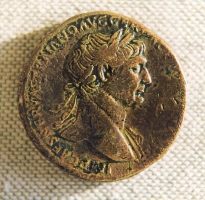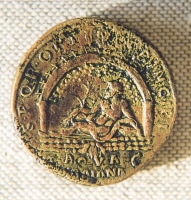Concrete figures for the costs of aqueducts:
- 350.000 sesterces for the Aqua Claudia aqueduct of Rome (Pliny NH 36.122)
- 400.000 sesterces for the upkeep of the water supply in Pola (CIL 5.47; II 10,1,70)
- 600.000 sesterces, a bequest from a woman in Verona (CIL 5.3402)
- 8.000.000 sesterces for the aqueduct of Aspendos was given by a donor (IGRR 3.804)
- 12.000.000 (initial costs) plus 16.000.000 (supplement) sesterces for an aqueduct of Alexandreia Troas by the father of
Herodes Atticus (Philostratus VS 548-9; Graindor 1930 pag 32,72)
- 180.000.000 sesterces for the restoration of the Aquae Appia and the Anio Vetus, and the construction of the Aqua Marcia, Rome
(Frontinus 7) [2 Million sesterces/km, Kek1994]
- 350.000.000 sesterces for the construction of the Aquae Claudia and Anio Novus, Rome (Pliny NH 36.122) [2,25 Million sesterces/km, Kek1994]
- 3.518.000 sesterces already spend to an aqueduct in Nicomedia (Pliny the Younger 10,37)
- 100.000 sesterces for the aqueduct of Perusia (CIL 11.1946)
- 2.000.000 sesterces "for waters" (construction or repair of the aqueduct ?) of Bordeaux by C. Julius Secundus (CIL 13.596).
References / inscriptions to public expenditures for the water supply (Frank1940; Kek1994):
- CIL 9.3308 (Corfinium)
- CIL 9. 3312 (Superaequum)
- CIL 9.3351 (Pinna)
- CIL 9. 5360 (Firmum)
- CIL 10.5670 (Arpinum)
- CIL 10.6526 (Cora)
- CIL 11.6068 (Urbinum)
- CIL 10.4842 (Venafrum): Augustus built the aqueduct (also NS 1926 pag 434-437)
- CIL 5.4307 (Brixia): Augustus and Tiberius built the aqueduct
- CIL 10.1496 (Naples): Hadrian built the aqueduct
- CIL 9.5681 (Cingulum): Hadrian built the aqueduct
- CIL 10.103 (Scolacium): Antoninus Pius donated for the water supply.
References / inscriptions to private expenditures for the water supply (Frank1940; Kek1994):
- CIL 5.47 (II 10,1,70) (Pola) by L. Menucius Priscus
- CIL 5.3402 (Verona) (see ILS 5757?)
- CIL 9.665 (Ausculum)
- CIL 9.3018 (Teate) (bluilt by Asinus Gallus whose father was a native there)
- CIL 9.4130 (Aequiculi)
- CIL 9.4786 (Forum Novum)
- CIL 9.5652 (Trea)
- CIL 9.5852 (Auximum)
- CIL 10.4833 (Rufrae)
- CIL 10.5163 (Casinum)
- CIL 10.5411 (Aquinum)
- CIL ??? (Ephesus) by C. Sextilius Pollio
- 50.000 sesterces for the upkeep of inscriptions commemorating the gift to the colony of Vienne (...) by Q Gellius Capella and D. Sulpicius Censor of a new water supply (CIL 12.1882 - 1888)
- CIL 14.2121 (Lanuvium) by M. Valerius just three miles af the aqueduct
- Lucianus Peregrinus 19f (Olympia) gift by Herodes Atticus
- IvE 2,424 - AE1967, 467 (Ephesus) a complete 210 stadia (38 km) long aqueduct by Tiverius Claudius Aristio
- CIL 2.3240 (Ilugo) complete aqueduct, gift by a woman Annia Victorina
- Frontinus XX (the Aquae Julia and Virgo were paid by Agrippa - possibly by the booties after the victory over
Marcus Antonius and Cleopatra; Kek 1994)
Reference values:
- part-time scriba earned annually 800- 1.200 sesterces
- At Altinum a citizen gave 1.600.000 sesterces, specifying that 800.000 should go to the restoration of the bath, 400.000
towards endowing the furnaces, 200.000 to endow the service, and 200.000 to entertain the citizens (NS 1928, 283) (Frank 1940 pag 98)
- Tempel of Genius Lambaesis in Lambaesis 600.000 sesterces, the expenses for the temples in Calama, Leptis Magna, and
Thugga were 350.000, 200.000 and 120.000 sesterces (Kek 1994)
- A theater in Madauros 375.000 and a Baths in Thagura 400.000 sesterces
- Pliny the Younger paid for a library in Comum 1.000.000 sesterces
- The minimum wealth of a Roman senator as required was 1,2 million sesterces (Suetonius: The Twelve Caesars, paragraph 41)
|



